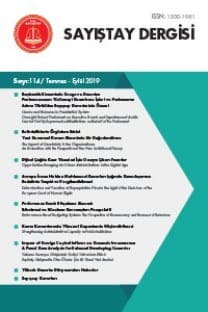TAKİPTEKİ KREDİLER ORANI VE MEVDUATLARIN BANKACILIKTA ZİMMET SUÇUNA ETKİLERİ
THE EFFECTS OF NON-PERFORMING LOANS RATIO AND DEPOSITS ON BANK EMBEZZLEMENT
___
- Adeoye, Martin ve Ebunoluwa Adeoye (2014), “Drift of Risk Assessment of Prevention of Fraud in Banks and Financial Institutions in Nigeria”, Computing, Information Systems, Development Informatics and Allied Research Journal, Vol. 5, No. 2: 13-28.
- Agung, Gusti Ngurah (2009), Time Series Data Analysis Using Eviews, Wiley Statistics in Practice, USA.
- Aidt, Toke S. (2009), “Corruption, Institutions and Economic Development”, Oxford Review of Economic Policy, Vol. 25, No. 2: 271-291.
- Ajala, Oladayo Ayorinde, Toyin Amuda, Leye Arulogun (2013), “Evaluating Internal Control System as Preventive Measure of Fraud in the Nigerian Banking Sector”, International Journal of Management Sciences and Business Research, Vol. 2, No. 9: 15-22.
- Ajao, Isaac O, Femi J. Ayoola, Joseph O. Iyanıwura (2015), “Temporal Disaggregation Methods in Flow Variables of Economic Data: Comparison Study”, International Journal of Statistics and Probability, Vol. 5, No. 1: 36-45.
- Akindele, Richard Iyiola (2011), “Fraud as a Negative Catalyst in the Nigerian Banking Industry”, Journal of Emerging Trends in Economics and Management Sciences, Vol. 2, No. 5: 357-363.
- Akinyomi, Oladele John (2012), “Examination of Fraud in the Nigerian Banking Sector and its Prevention”, Asian Journal of Management Research, Vol. 3, No. 1: 184-192.
- Alao, Adeniyi A. (2016), “Analysis of Fraud in Banks: Evidence from Nigeria”, International Journal of Innovative Finance and Economics Research, Vol. 4, No. 2: 16-25.
- Albanese, Jay S. (2008), “White Collar Crimes and Casino Gambling: Looking for Empirical Links to Forgery, Embezzlement and Fraud”, Crime Law and Social Change, Vol. 49, No. 5: 333-347.
- Baba, Yasemin (2012), “5411 sayılı Bankacılık Kanunu’nda Düzenlenen Zimmet Suçu Bağlamında Etkin Pişmanlık Uygulaması”, TAAD, Sayı: 9, Nisan: 253-280.
- Blanchard, Olivier, Pedro Portugal (2017), “Boom, Slump, Sudden Stops, Recovery and Policy Options: Portugal and the Euro”, GEE Papers No. 72.
- Çilingirtürk, Mete (2004), “Hukuk Mahkemelerinde Dava ve Mahkeme Sayılarının Öngörüsüne İlişkin Model”, TBB Dergisi, No. 54: 33-50.
- Cressey, Donald R. (1953), Other People’s Money: A Study in the Social Psychology of Embezzlement, Glencoe, The Free Press, Illinois.
- Dimant, Eugen, Guglielmo Tosato (2017), “Causes and Effects of Corruption: What has Past Decade’s Empirical Research Taught Us? A Survey”, Journal of Economic Surveys, doi:10.1111/joes.12198.
- Emmy, Osuala, Opara Confidence Chinwe, Okoro Charles Emmanuel (2016), “Impact of Fraud on Risk Assets of Nigerian Commercial Banks”, Journal of Finance and Economic Research, Vol. 3, No. 1: 81-96.
- Geppert, June Panter (2016), Relationship of Embezzlement and the Economic Condition in the United States Economy, Dissertation Thesis, Capella University, May.
- Ghasemi, Mojtaba (2017), “Crime and Punishment: Evidence from Dynamic Panel Data Model for North Carolina (2003-2012)”, Empirical Economics, Vol. 52: 723-730.
- Gujarati, Damodar (2015), Econometrics by Example, Macmillan Education, Palgrave Publications, Second Edition, USA.
- Hulsart, Robyn W., Kim M. James, Dana M. Cummings (2012), “Fraud in the Lost Decade: The Impact of the Economic Downturn on the Prevalence of Fraud”, Business Studies Journal, Vol. 4, No. 1: 9-24.
- Karamanoğlu, Yunus Emre, Yılmaz Akdi, Afşin Şahin (2014), “Unemployment by Education Status, Prices and Crime Relationship: Evidence from Turkey”, Güvenlik Bilimleri Dergisi, Vol. 3, No. 2: 127-153.
- Kirk, David (2008), “Opinion: Fighting Fraud”, Journal of Criminal Law, Vol. 72, No. 5: 335-337.
- Krugman, Paul (2017), “Why We are in a New Gilded Age”, in: After Piketty, the Agenda for Economics and Inequality, (Eds.) Boushey, Heather, Delong, Bradford J., Steinbaum, Marshall, Harvard University Press, Cambridge, London, England: 60-71.
- Lata, Robeya Sultana (2015), “Non-Performing Loans and Profitability: The Case of State Owned Commercial Banks in Bangladesh”, World Review of Business Research, Vol. 5, No. 3: 171-182.
- Ojeaga, Paul, O. Ikpefan, Deborah Odejimi (2013), “Do High Customer Bank Deposits Incite Management Fraud? Examining Causes of Management Fraud in the Nigerian Banking Sector”, Working Paper.
- Povel, Paul, Rajdeep Singh, Andrew Winton (2007), “Booms, Busts and Fraud”, Review of Financial Studies, Vol. 20, No. 4: 1219-1254.
- Rashid, Abdul, Zanaib Jehan (2013), “Derivation of Quarterly GDP, Investment Spending and Government Expenditure Figures from Annual Data: The Case of Pakistan”, MPRA Paper No. 46937: 1-68.
- Rawlings, John O., Sastry G. Pantula, David A. Dickey (2016), Uygulamalı Regresyon Analizi, (Çev. Ed. Yılmaz Akdi, Afşin Şahin), Ankara: Nobel Akademik Yayıncılık, No. 1655.
- Sax, Christoph, Peter Steiner (2013), “Temporal Disaggregation of Time Series”, The R Journal, Vol. 5, No. 2: 80-87.
- Tanzi, Vito (1998), “Corruption around the World: Causes, Consequences, Scope and Cures”, IMF Working Paper.
- Tanzi, Vito, Hamid R. Davoodi (2000), “Corruption, Growth and Public Finances”, IMF Working Paper No. WP/00/182, USA.
- TBB (2016a), Türkiye’de Bankacılık Sektörü, 2012-2016, Türkiye Bankalar Birliği, İstanbul, Türkiye.
- TBB (2016b), “Bankaların Bilanço Büyüklüğüne İlişkin Bilgi Notu”, Türkiye Bankalar Birliği, Şubat, İstanbul, Türkiye.
- TBB (2017), Uluslararası Karşılaştırmalar İtibariyle Bankacılık Sektörü, Ocak, Türkiye Bankalar Birliği, İstanbul, Türkiye.
- Us, Vuslat (2016), “Determinants of Non-Performing Loans in the Turkish Banking Sector: What has Changed after the Global Crisis?”, CBRT Research Notes in Economics, No. 2016-27, September: 1-14.
- Wooldridge, Jeffrey M. (2013), Introductory Econometrics: A Modern Approach, 5th Edition, South-Western Cengage Learning, USA.
- ISSN: 1300-1981
- Yayın Aralığı: 4
- Başlangıç: 1990
- Yayıncı: T.C. Sayıştay Başkanlığı
YÜKSEK DENETİM KURUMLARINDA ETİK YÖNETİM ALTYAPI VE UYGULAMALARI
Emine ÇELİKSOY, Ela ÖZKAN CANBOLAT
ÖZEL SEKTÖR MOTİVASYON ARAÇLARININ TÜRK KAMU SEKTÖRÜNDE UYGULANABİLİRLİĞİ
SAĞLIK SEKTÖRÜNDE BÜTÇE ETKİ ANALİZİ
TAKİPTEKİ KREDİLER ORANI VE MEVDUATLARIN BANKACILIKTA ZİMMET SUÇUNA ETKİLERİ
